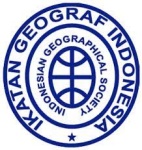The Meaning of Place in Historic Building (Case Study: Three Urban Heritage Tourism Destinations at Kesawan Medan)
Abstract
Based on the Regional Spatial Planning of Medan City for the years 2011-2031, several Cultural Heritage Areas have been established that include various historical buildings, one of which is located in the Old City area of Kesawan. The presence of historical buildings such as the Lonsum Building, Tjong A Fie, and Pos Bloc coexists with the rapid business and culinary activities on Ahmad Yani Street and Balai Kota Street. There are indications that a shift in visitation orientation has occurred where the meaning of tourism is stronger compared to a comprehensive exploration of history. The aim of this research is to analyze the meaning of place at three historical buildings and its implications for regional development. This research is qualitative with a geographical approach. In-depth interviews were conducted with 36 informants selected through purposive sampling. The research results show that the meaning of place in the three historical buildings is more dominated functionally, socially, and emotionally than by regional romanticism. The shift in the meaning of historical buildings is a consequence of the massive development of alternative tourism in urban areas. Therefore, it is necessary to reorganize the cultural heritage area involving elements of the community, government, and private sector, with the hope that the authentic value of historical buildings is not entirely eroded by the modernity of urban development.
References
Almadina, A. F., & Marcillia, S. R. (2023). Preferensi Setting Pendukung Aktivitas Gen Z di Ruang Terbuka Publik, Studi Kasus: Alun-Alun Kidul Yogyakarta. Jurnal Arsitektur Pendapa, 6(2), 89-95. Retrieved from https://ejournal.widyamataram.ac.id/index.php/pendapa/article/view/926
Ardoin, N. M., Schuh, J. S., & Gould, R. K. (2012). Exploring the Dimensions of place: A Confirmatory Factor Analysis of Data from Three Ecoregional Sites. Environmental Education Research, 18(5), 583–607. https://doi.org/10.1080/13504622.2011.640930
Avriel-Avni, N., Spektor-Levy, O., Zion, M., & Levi, N. R. (2010). Children’s Sense of Place in Desert Towns: A Phenomenographic Enquiry. International Research in Geographical and Environmental Education, 19(3), 241–259. https://doi.org/10.1080/10382046.2010.496987
Bramantio, B., Nugraha, F. A., & Cahyaningsih, A. F. (2025). Management Evaluation of the Parangtritis Sand Dunes Tourist Attraction Using the DPSIR Approach. Jurnal Penelitian Geografi, 13(1), 23–36. http://dx.doi.org/10.23960/jpg.v13.i1.33533
Brehm, J. M., Eisenhauer, B. W., & Stedman, R. C. (2013). Environmental Concern: Examining the Role of Place Meaning and Place Attachment. Society and Natural Resources, 26(5), 522–538. https://doi.org/10.1080/08941920.2012.715726
Buchori, A. (2022). Daya Tawar Warisan Budaya Kota Lama Semarang Sebagai Daya Tarik Wisata Melalui Program Revitalisasi. Kepariwisataan: Jurnal Ilmiah, 16(2), 127-136. http://dx.doi.org/10.47256/kji.v16i2.163
Christyawaty, E. (2018). Rumah Tinggal Tjong A Fie: Akulturasi dalam Arsitektur Bangunan pada Akhir Abad ke-19 di Kota Medan. Berkala Arkeologi Sangkhakala, 14(27), 52–70. https://doi.org/10.24832/bas.v14i27.158
Dameria, C., Akbar, R., & Natalivan, P. (2017). Siapa Pemilik Sense of Place? Tinjauan Dimensi Manusia dalam Konservasi Kawasan Pusaka Kota Lama. Seminar Ikatan Peneliti Lingkungan Binaan Indonesia, B235–B240. https://doi.org/10.32315/sem.1.b235
Davis, P., Huang, H.- yin, & Liu, W.- chen. (2015). Heritage, Local Communities and the Safeguarding of ‘Spirit of Place’ in Taiwan. Museum & Society, 8(2), 80–89. https://doi.org/10.29311/mas.v8i2.155
Debenedetti, A. (2021). Luxury Stores as Home-Like Places: How Domestic Meanings are Staged and Mobilized in Luxury Retail. Journal of Business Research, 129, 304–313. https://doi.org/10.1016/j.jbusres.2021.03.010
Eisenhauer, B. W., Krannich, R. S., & Blahna, D. J. (2000). Attachments to Special Places on Public Lands: An Analysis of Activities, Reason for Attachments, and Community Connections. Society and Natural Resources, 13(5), 421–441. https://doi.org/10.1080/089419200403848
Ergler, C. R., Freeman, C., & Latai, A. (2020). Samoan Children’s Sense of Place: Experiential Landscapes in an Urban Village. Asia Pacific Viewpoint, 61(2), 391–398. https://doi.org/10.1111/apv.12263
Fadila, C. D., Sari, S. N., Anisa, B. B., Yunita, M., Alfi, M., Rahayu, Y. P., & Fitriana, D. (2025). Kaba Volcano Disaster Mitigation Analysis in Rejang Lebong Regency, Bengkulu Province. Jurnal Penelitian Geografi, 13(1), 177–186. https://doi.org/10.23960/jpg.v13.i1.30684
Faruq, Fadli M., and Tucunan P. Tucunan. "Konsep Ruang pada Kawasan Heritage Pecinan Kota Bandung (Studi Kasus: Kawasan Heritage Pecinan Kota Bandung)." Jurnal Teknik ITS, vol. 10, no. 2, 2021, doi:10.12962/j23373539.v10i2.65336.
Farnum, J. (2005). Sense of Place in Natural Resource Recreation and Tourism: An Evaluation and Assessment of Research Findings.
Fauziah, H. M., Dewi Susilowati, M. H., Guswandi, G., & Anggrahita, H. (2023). Pemaknaan tempat bagi konsumen pada restoran di Jalan Cipete Raya, Jakarta Selatan. Dkk/Majalah Geografi Indonesia, 37(1), 60–68. https://doi.org/10.22146/mgi.73723
Garavito-Bermúdez, D., & Lundholm, C. (2017). Exploring Interconnections Between Local Ecological Knowledge, Professional Identity and Sense of Place Among Swedish Fishers. Environmental Education Research, 23(5), 627–655. https://doi.org/10.1080/13504622.2016.1146662
Kusuma, G. C., & Fitri, H. N. (2024). Daya Tarik Perubahan Taman RA Kartini Cimahi Sebagai Alternatif Berwisata. Nawasena: Jurnal Ilmiah Pariwisata, 3(3), 77-82. https://doi.org/10.56910/nawasena.v3i3.1855
Halpenny, E. A. (2010). Pro-Environmental Behaviours and Park Visitors: The Effect of Place Attachment. Journal of Environmental Psychology, 30(4), 409–421. https://doi.org/10.1016/j.jenvp.2010.04.006
Hawke, S. K. (2011). Local Residents Exploring Heritage in the North Pennines of England: Sense of Place and Social Sustainability. In International Journal of Heritage and Sustainable Development (Vol. 1, Issue 1). Retrieved from https://www.academia.edu/36051973/Local_residents_exploring_heritage_in_the_North_Pennines_of_England_sense_of_place_and_social_sustainability_Introduction_and_context
Hayati, R. (2014). Pemanfaatan Bangunan Bersejarah Sebagai Wisata Warisan Budaya di Kota Makassar. Jurnal Master Pariwisata (JUMPA). https://doi.org/10.24843/jumpa.2014.v01.i01.p01
Hikmah, N., Fauziyah, N. K., Septiani, M., & Lasari, D. M. (2022). Healing Sebagai Strategi Coping Stress Melalui Pariwisata. Indonesian Journal of Tourism and Leisure, 3(2), 113–124. https://doi.org/10.36256/ijtl.v3i2.308
Hutapea, E. A., & Siregar, Y. D. (2023). Kegiatan Preservasi dan Konservasi Koleksi Kantor Pos Besar Kota Medan Pasca Alih Fungsi ke Pos Bloc. Mukadimah: Jurnal Pendidikan, Sejarah, Dan Ilmu-Ilmu Sosial, 7(2), 252–264. https://doi.org/10.30743/mkd.v7i2.7547
Isnaniyah, Z., Sri Mulyawati, L., & Mujio, M. (2024). Arahan Pengembangan Wisata di Kawasan Banten Lama. Jendela Kota: Jurnal Perencanaan dan Pengembangan Wilayah Dan Kota, 1(2), 12–24. https://doi.org/10.33751/jekota.v1i2.53
Jorgensen, B. S., & Stedman, R. C. (2001). Sense of Place as an Attitude: Lakeshore Owners Attitudes Toward Their Properties. Journal of Environmental Psychology, 21(3), 233–248. https://doi.org/10.1006/jevp.2001.0226
Kagungan, D., Zainal, A. G., & Rosalia, F. (2021). Genpi’s Strategy in the Development Digital Tourism Destination in Lampung Province. Sosiohumaniora, 23(2), 177. https://doi.org/10.24198/sosiohumaniora.v23i2.30912
Kianicka, S; Buchecker, M; Hunziker, M; Müller-Böker, Ulrike (2006). Locals’ and Tourists’ Sense of Place: A Case Study of a Swiss Alpine Village. Mountain Research and Development, 26(1):55-63. https://doi.org/10.5167/uzh-2621
Kurniasari, K. K., Gauh Perdana, B. E., Sukaca Putra, R. A., & Iban, C. (2024). Persepsi Generasi Z Terhadap Pariwisata Berkelanjutan Pada Destinasi Budaya: Studi Kasus Borobudur. Jurnal Pariwisata Terapan, 8(1), 12. https://doi.org/10.22146/jpt.95415
Latifah, A. S., & Hudiono, R. K. (2020). Analisis Profil Wisatawan Objek Wisata Gazebo Di Desa Wisata Kemetul Kabupaten Semarang. Kritis, 29(1), 1-19. https://doi.org/10.24246/kritis.v29i1p1-19
Lemaaniah, Z. M., & Riyayanatasya, Y. W. (2025). Mapping the Tourism Potential of Labuan Tereng Village, West Lombok Regency. Jurnal Penelitian Geografi, 13(1), 13-22. http://dx.doi.org/10.23960/jpg.v13. i1.33487
Liem, Y., & Lake, R. C. (2018). Pemaknaan Ruang Terbuka Publik Taman Nostalgia Kota Kupang. https://doi.org/10.30822/arteks.v2i1.48
Lindarto, D., & Eddy, F. (2016). Jelajah Tempat Berkarakter bagi Model Revitalisasi Pasar Petisah Medan. In Prosiding Seminar Nasional IPLBI. Retrieved from https://temuilmiah.iplbi.or.id/wp-content/uploads/2022/10/IPLBI-2017-C-037-042-Model-Desain-Revitalisasi-Kawasan-Pasar-Petisah-Medan.pdf
Manzo, L. C. (2005). For Better or Worse: Exploring Multiple Dimensions of Place Meaning. Journal of Environmental Psychology, 25(1), 67–86. https://doi.org/10.1016/j.jenvp.2005.01.002
Martokusumo, W. (2017). Pemaknaan Tempat Dalam Pelestarian Arsitektur. In Prosiding Seminar Heritage IPLBI (Vol. 1). Retrieved from https://seminar.iplbi.or.id/pemaknaan-tempat-dalam-pelestarian-arsitektur/
Nindhita, V., & Arifin, A. (2024). Analisis Faktor Penyebab Fenomena Ngopi Dalam Budaya Work From Cafe: Studi Perilaku Konsumen. Journal of Social, Culture, and Language, 2(2), 25-32.https://doi.org/10.21107/jscl.v2i2.25591
Nugraha, S. B., Suharini, E., Mukhlas, A. B., Saputro, F. W., Fajri, Z. A., Kinanthi, Y., Prasetyo, S. J., & Fauzia, H. (2021). Pengaruh Penataan Kawasan Kota Lama Semarang pada Aspek Ekonomi dan Sosial. Jurnal Geografi : Media Informasi Pengembangan Dan Profesi Kegeografian, 18(1), 21–29. https://doi.org/10.15294/jg.v18i1.27512
Nur Alif, B. I., & Saputra, Y. W. (2025). Analysis of the Development of Wanadesa Bamboe Forest Tourism as Ecotourism. Jurnal Penelitian Geografi, 13(1), 51–62. http://dx.doi.org/10.23960/jpg.v13.i1.33538
Peng, J., Strijker, D., & Wu, Q. (2020). Place Identity: How Far Have We Come in Exploring Its Meanings? In Frontiers in Psychology (Vol. 11). Frontiers Media S.A. https://doi.org/10.3389/fpsyg.2020.00294
Pettricia, H. A., Wardhani, D. K., & Antariksa, A. (2014). Elemen Pembentuk Citra Kawasan Bersejarah Di Pusat Kota Malang. RUAS, 12(1), pp.10–23. https://doi.org/10.21776/ub.ruas.2014.012.01.2
Prabhaswara, F. S., & Ulfa, N. S. (2024). Pengaruh Motivasi Wisatawan Kota Lama Semarang Pada Perilaku Membaca Informasi Wisata Sejarah. Interaksi Online, 12(4), 963-974. Retrieved from https://ejournal3.undip.ac.id/index.php/interaksi online/article/view/47467
Prasetio, C. E., Sirait, E. G. N., & Hanafitri, A. (2020). Rumah, Tempat Kembali: Pemaknaan Rumah pada Mahasiswa Rantau. Mediapsi, 6(2), 132–144. https://doi.org/10.21776/ub.mps.2020.006.02.7
Rahardjo, S. (2013). Beberapa Permasalahan Pelestarian Kawasan Cagar Budaya Dan Strategi Solusinya. Jurnal Konservasi Cagar Budaya Borobudur Vol 7 No 2. 4-17 https://doi.org/10.33374/jurnalkonservasicagarbudaya.v7i2.109
Rajala, K., Sorice, M. G., & Thomas, V. A. (2020). The Meaning(S) of Place: Identifying The Structure of Sense of Place Across a Social–Ecological Landscape. People and Nature, 2(3), 718–733. https://doi.org/10.1002/pan3.10112
Resor, C. W. (2010). Place-Based Education: What is Its Place in the Social Studies Classroom? The Social Studies, 101(5), 185–188. https://doi.org/10.1080/00377990903493853
Rudiansyah, R. (2021). Tipomorfologi Arsitektur Bangunan Pecinan di Kesawan Medan. Berkala Arkeologi Sangkhakala, 24(2), 135–146. https://doi.org/10.24832/bas.v24i2.460
Sasmitasari, A. S. A., & Handayani, N. S. (2022). Strategi Preservasi dan Konservasi Bahan Pustaka di Dinas Perpustakaan dan Kearsipan Kabupaten Lamongan. Tibanndaru: Jurnal Ilmu Perpustakaan dan Informasi, 6(1). Retrieved from https://journal.uwks.ac.id/index.php/Tibandaru/article/view/1794
Sebastien, L. (2020). The Power of Place in Understanding Place Attachments and Meanings. Geoforum, 108, 204–216. https://doi.org/10.1016/j.geoforum.2019.11.001
Sidabutar, Yuanita FD, Sirojuzilam, Suwardi, & Rujiman. (2018). Bangunan Bersejarah di Kawasan Kesawan dan Lapangan Merdeka Mendukung Aktivitas Pengembangan Wilayah di Kota Medan. Jurnal Koridor, 9(2), 335–344. https://doi.org/10.32734/Koridor.V9i2.1376
Sidabutar, Y. F. (2022). Pengaruh Kualitas Bangunan dan Kondisi Lingkungan Terhadap Partisipasi Masyarakat Pada Bangunan Bersejarah di Kota Medan. In Talenta Conference Series: Energy and Engineering (EE) (Vol. 5, No. 1, pp. 421-426). https://doi.org/10.32734/ee.v5i1.1495
Sun, J., Chen, P. J., Ren, L., Shih, E. H. W., Ma, C., Wang, H., & Ha, N. H. (2021). Place Attachment to Pseudo Establishments: an Application of the Stimulus-Organism-Response Paradigm to Themed Hotels. Journal of Business Research, 129, 484–494. https://doi.org/10.1016/j.jbusres.2020.10.005
Sunjayadi, A. (2019). Pariwisata Sejarah Untuk Generasi Milenial Dan Generasi Z. Abad Jurnal Sejarah, 3(1), 28-41. Retrieved from https://scholar.ui.ac.id/en/publications/pariwisata-sejarah-untuk-generasi-milenial-dan-generasi-z
Tampubolon, Meta V. (2020) "Citra dan Harapan terhadap Kawasan Kesawan di Kota Medan." Nalars, 19(1) 59-68. https://doi.org/10.24853/nalars.19.1.59-68
Tampubolon, M. V., & Kusuma, H. E. (2020). Empat Perspektif Citra dan Harapan terhadap Kawasan Kesawan Kota Medan: Konservasi, Pariwisata, Revitalisasi, dan Pengembangan. RUAS, 18(2), 1–11. https://doi.org/10.21776/ub.ruas.2020.018.02.1
Tobler, W. R. (1970). A Computer Movie Simulating Urban Growth in the Detroit Region. Economic Geography, 46, 234–240. https://doi.org/10.2307/143141
Tuan, Y.-F. (1975). Place: An Experiential Perspective. Geographical Review, 65(2), 151. https://doi.org/10.2307/213970
Ujang, N. (2014). Place Meaning and Significance of the Traditional Shopping District in the City Centre of Kuala Lumpur, Malaysia. Archnet-IJAR: International Journal of Architectural Research, 8(1), 66–77. https://doi.org/10.26687/archnet-ijar.v8i1.338
Ulva, N., Halifah Mustami, M., & Aksa, N. (2022). Revitalisasi Kawasan Bersejarah Sebagai Objek Wisata. Journal of Social Knowledge Education (JSKE), 3(1), 1–5. https://doi.org/10.37251/jske.v3i1.399
Wachidatullailiya, M., Adawiyah, R., Intan, P. A., Sinaga, E. F., Wibawa, Y. P. W., Hariyanto, B., & Sitohang, L. L. (2025). Conservation Practices of Volcanic Landforms in Eruption Mitigation in the Southern Merapi Region, Klangon Hill, Daerah Istimewa Yogyakarta. Jurnal Penelitian Geografi, 13(1), 37–50. http://dx.doi.org/10.23960/jpg.v13.i1.33536
Yulianto, I., & Estikowati, E. (2022). The Existence of the Community of Historical Interest In the Effort of Preserving the Cultural Conservation of Malang City. Jurnal Pariwisata Pesona, 7(2), 334–340. https://doi.org/10.26905/jpp.v7i2.7692
Zarezadeh, Z., Benckendorff, P., & Gretzel, U. (2019). Lack of Progress in Tourist Information Search Research: a Critique of Citation Behaviour and Knowledge Development. Current Issues in Tourism, 22(19), 2415–2429. https://doi.org/10.1080/13683500.2018.1459511
Refbacks
- There are currently no refbacks.
INDEX JOURNAL


















